Balbharti Maharashtra State Board Class 10 Maths Solutions covers the Practice Set 2.2 Geometry 10th Class Maths Part 2 Answers Solutions Chapter 2 Pythagoras Theorem.
10th Standard Maths 2 Practice Set 2.2 Chapter 2 Pythagoras Theorem Textbook Answers Maharashtra Board
Class 10 Maths Part 2 Practice Set 2.2 Chapter 2 Pythagoras Theorem Questions With Answers Maharashtra Board
Question 1.
In ∆PQR, point S is the midpoint of side QR. If PQ = 11, PR = 17, PS = 13, find QR.
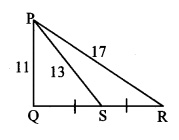
Solution:
In ∆PQR, point S is the midpoint of side QR. [Given]
∴ seg PS is the median.
∴ PQ
2
+ PR
2
= 2 PS
2
+ 2 SR
2
[Apollonius theorem]
∴ 11
2
+ 17
2
= 2 (13)
2
+ 2 SR
2
∴ 121 + 289 = 2 (169)+ 2 SR
2
∴ 410 = 338+ 2 SR
2
∴ 2 SR
2
= 410 – 338
∴ 2 SR
2
= 72
∴ SR
2
= \(\frac { 72 }{ 2 } \) = 36
∴ SR = \(\sqrt{36}\) [Taking square root of both sides]
= 6 units Now, QR = 2 SR [S is the midpoint of QR]
= 2 × 6
∴ QR = 12 units
Question 2.
In ∆ABC, AB = 10, AC = 7, BC = 9, then find the length of the median drawn from point C to side AB.
Solution:
Let CD be the median drawn from the vertex C to side AB.
BD = \(\frac { 1 }{ 2 } \) AB [D is the midpoint of AB]
= \(\frac { 1 }{ 2 } \) × 10 = 5 units
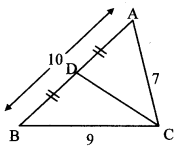
In ∆ABC, seg CD is the median. [Given]
∴ AC
2
+ BC
2
= 2 CD
2
+ 2 BD
2
[Apollonius theorem]
∴ 7
2
+ 9
2
= 2 CD
2
+ 2 (5)
2
∴ 49 + 81 = 2 CD
2
+ 2 (25)
∴ 130 = 2 CD
2
+ 50
∴ 2 CD
2
= 130 – 50
∴ 2 CD
2
= 80
∴ CD
2
= \(\frac { 80 }{ 2 } \) = 40
∴ CD = \(\sqrt { 40 }\) [Taking square root of both sides]
= 2 \(\sqrt { 10 }\) units
∴ The length of the median drawn from point C to side AB is 2 \(\sqrt { 10 }\) units.
Question 3.
In the adjoining figure, seg PS is the median of APQR and PT ⊥ QR. Prove that,
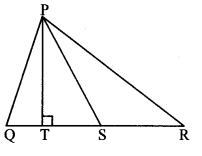
i. PR
2
= PS
2
+ QR × ST + (\(\frac { QR }{ 2 } \))
2
ii. PQ
2
= PS
2
– QR × ST + (\(\frac { QR }{ 2 } \))
2
Solution:
i. QS = SR = \(\frac { 1 }{ 2 } \) QR (i) [S is the midpoint of side QR]
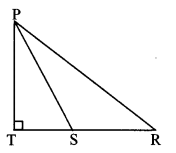
∴ In ∆PSR, ∠PSR is an obtuse angle [Given]
and PT ⊥ SR [Given, Q-S-R]
∴ PR
2
= SR
2
+PS
2
+ 2 SR × ST (ii) [Application of Pythagoras theorem]
∴ PR
2
= (\(\frac { 1 }{ 2 } \) QR)
2
+ PS
2
+ 2 (\(\frac { 1 }{ 2 } \) QR) × ST [From (i) and (ii)]
∴ PR
2
= (\(\frac { QR }{ 2 } \))
2
+ PS
2
+ QR × ST
∴ PR
2
= PS
2
+ QR × ST + (\(\frac { QR }{ 2 } \))
2
ii. In.∆PQS, ∠PSQ is an acute angle and [Given]
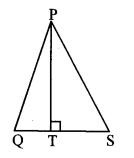
PT ⊥QS [Given, Q-S-R]
∴ PQ
2
= QS
2
+ PS
2
– 2 QS × ST (iii) [Application of Pythagoras theorem]
∴ PR
2
= (\(\frac { 1 }{ 2 } \) QR)
2
+ PS
2
– 2 (\(\frac { 1 }{ 2 } \) QR) × ST [From (i) and (iii)]
∴ PR
2
= (\(\frac { QR }{ 2 } \))
2
+ PS
2
– QR × ST
∴ PR
2
= PS
2
– QR × ST + (\(\frac { QR }{ 2 } \))
2
Question 4.
In ∆ABC, point M is the midpoint of side BC. If AB
2
+ AC
2
= 290 cm, AM = 8 cm, find BC.
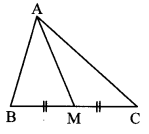
Solution:
In ∆ABC, point M is the midpoint of side BC. [Given]
∴ seg AM is the median.
∴ AB
2
+ AC
2
= 2 AM
2
+ 2 MC
2
[Apollonius theorem]
∴ 290 = 2 (8)
2
+ 2 MC
2
∴ 145 = 64 + MC
2
[Dividing both sides by 2]
∴ MC
2
= 145 – 64
∴ MC
2
= 81
∴ MC = \(\sqrt{81}\) [Taking square root of both sides]
MC = 9 cm
Now, BC = 2 MC [M is the midpoint of BC]
= 2 × 9
∴ BC = 18 cm
Question 5.
In the adjoining figure, point T is in the interior of rectangle PQRS. Prove that, TS
2
+ TQ
2
= TP
2
+ TR
2
. (As shown in the figure, draw seg AB || side SR and A – T – B)
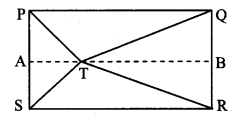
Given: ꠸PQRS is a rectangle.
Point T is in the interior of ꠸PQRS.
To prove: TS
2
+ TQ
2
= TP
2
+ TR
2
Construction: Draw seg AB || side SR such that A – T – B.
Solution:
Proof:
꠸PQRS is a rectangle. [Given]
∴ PS = QR (i) [Opposite sides of a rectangle]
In ꠸ASRB,
∠S = ∠R = 90° (ii) [Angles of rectangle PQRS]
side AB || side SR [Construction]
Also ∠A = ∠S = 90° [Interior angle theorem, from (ii)]
∠B = ∠R = 90°
∴ ∠A = ∠B = ∠S = ∠R = 90° (iii)
∴ ꠸ASRB is a rectangle.
∴ AS = BR (iv) [Opposite sides of a rectanglel
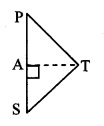
In ∆PTS, ∠PST is an acute angle
and seg AT ⊥ side PS [From (iii)]
∴ TP
2
= PS
2
+ TS
2
– 2 PS.AS (v) [Application of Pythagoras theorem]
In ∆TQR., ∠TRQ is an acute angle
and seg BT ⊥ side QR [From (iii)]
∴ TQ
2
= RQ
2
+ TR
2
– 2 RQ.BR (vi) [Application of pythagoras theorem]
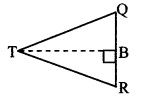
TP
2
– TQ
2
= PS
2
+ TS
2
– 2PS.AS
-RQ
2
– TR
2
+ 2RQ.BR [Subtracting (vi) from (v)]
∴ TP
2
– TQ
2
= TS
2
– TR
2
+ PS
2
– RQ
2
-2 PS.AS +2 RQ.BR
∴ TP
2
– TQ
2
= TS
2
– TR
2
+ PS
2
– PS
2
– 2 PS.BR + 2PS.BR [From (i) and (iv)]
∴ TP
2
– TQ
2
= TS
2
– TR
2
∴ TS
2
+ TQ
2
= TP
2
+ TR
2
Question 1.
In ∆ABC, ∠C is an acute angle, seg AD Iseg BC. Prove that: AB
2
= BC
2
+ A
2
– 2 BC × DC. (Textbook pg. no. 44)
Given: ∠C is an acute angle, seg AD ⊥ seg BC.
To prove: AB
2
= BC
2
+ AC
2
– 2BC × DC
Solution:
Proof:
∴ LetAB = c, AC = b, AD = p,
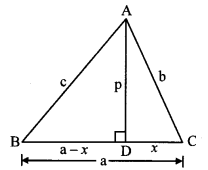
∴ BC = a, DC = x
BD + DC = BC [B – D – C]
∴ BD = BC – DC
∴ BD = a – x
In ∆ABD, ∠D = 90° [Given]
AB
2
= BD
2
+ AD
2
[Pythagoras theorem]
∴ c
2
= (a – x)
2
+ [P
2
] (i)
∴ c
2
= a
2
– 2ax + x
2
+ [P
2
]
In ∆ADC, ∠D = 90° [Given]
AC
2
= AD
2
+ CD
2
[Pythagoras theorem]
∴ b
2
= p
2
+ [X
2
]
∴ p
2
= b
2
– [X
2
] (ii)
∴ c
2
= a
2
– 2ax + x
2
+ b
2
– x
2
[Substituting (ii) in (i)]
∴ c
2
= a
2
+ b
2
– 2ax
∴ AB
2
= BC
2
+ AC
2
– 2 BC × DC
Question 2.
In ∆ABC, ∠ACB is an obtuse angle, seg AD ⊥ seg BC. Prove that: AB
2
= BC
2
+ AC
2
+ 2 BC × CD. (Textbook pg. no. 40 and 4.1)
Given: ∠ACB is an obtuse angle, seg AD ⊥ seg BC.
To prove: AB
2
= BC
2
+ AC
2
+ 2BC × CD
Solution:
Proof:
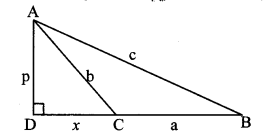
Let AD = p, AC = b, AB = c,
BC = a, DC = x
BD = BC + DC [B – C – D]
∴ BD = a + x
In ∆ADB, ∠D = 90° [Given]
AB
2
= BD
2
+ AD
2
[Pythagoras theorem]
∴ c
2
= (a + x)
2
+ p
2
(i)
∴ c
2
= a
2
+ 2ax + x
2
+ p
2
Also, in ∆ADC, ∠D = 90° [Given]
AC
2
= CD
2
+ AD
2
[Pythagoras theorem]
∴ b
2
= x
2
+ p
2
∴ p
2
= b
2
– x
2
(ii)
∴ c
2
= a
2
+ 2ax + x
2
+ b
2
– x
2
[Substituting (ii) in (i)]
∴ c
2
= a
2
+ b
2
+ 2ax
∴ AB
2
= BC
2
+ AC
2
+ 2 BC × CD
Question 3.
In ∆ABC, if M is the midpoint of side BC and seg AM ⊥seg BC, then prove that
AB
2
+ AC
2
= 2 AM
2
+ 2 BM
2
. (Textbook pg, no. 41)
Given: In ∆ABC, M is the midpoint of side BC and seg AM ⊥ seg BC.
To prove: AB
2
+ AC
2
= 2 AM
2
+ 2 BM
2
Solution:
Proof:
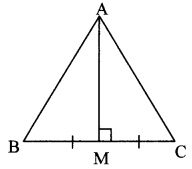
In ∆AMB, ∠M = 90° [segAM ⊥ segBC]
∴ AB2 = AM2 + BM2 (i) [Pythagoras theorem]
Also, in ∆AMC, ∠M = 90° [seg AM ⊥ seg BC]
∴ AC2 = AM2 + MC2 (ii) [Pythagoras theorem]
∴ AB
2
+ AC
2
= AM
2
+ BM
2
+ AM
2
+ MC
2
[Adding (i) and (ii)]
∴ AB
2
+ AC
2
= 2 AM
2
+ BM
2
+ BM
2
[∵ BM = MC (M is the midpoint of BC)]
∴ AB
2
+ AC
2
= 2 AM
2
+ 2 BM
2